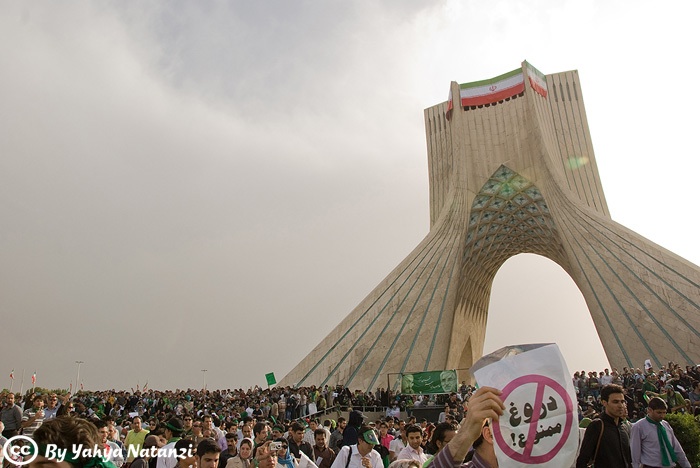Complexity, Social Media & Iran
I’ve been hesitant to write about the Iranian election and the role (or possible role) of social media in its aftermath in the last two+ weeks. Initially, quite a lot was written about social media’s place in the demonstrations and calls for a recount or new election, with some calling it a “Twitter Revolution” (see Moldova’s so-called “Twitter Revolution.“) But it was unclear to me at that early stage what the final outcome might bring. “Social media transforms Iran!” just didn’t seem a likely end result.
These two pieces seemed to be a challenge:
First, I know very little about Iran – its politics or particular religious practices – but what little I do know has left me with the impression that it’s a complex mix of BOTH politics and religion, entirely foreign to most Americans. While in the days (and even week) after the Iranian election there seemed to be a small hope that either the political or religious bodies might accept the calls for a recount or new election, it seemed unlikely that BOTH would.
Second, I was uncomfortable actively supporting the challenger Mir-Hossein Mousavi without knowing a great deal about him. Three years ago I briefly met Mohammad Khatami, a former president of Iran (who supported Mousavi in this last election), at a press conference. While moderate and reformist compared to Ahmadinejad, at the press conference I attended Khatami didn’t directly address the Holocaust but left open some interpretation of the facts, and expressed support for Iran’s right to develop a nuclear capability. That experience left me agreeing with Thomas Friedman that “moderate” in Iranian politics is a relative term (“The Virtual Mosque“). Mousavi clearly has outlined a different political agenda than Khatami – I’m certainly not trying to equate the two. I would simply argue that we can’t oversimplify Iranian politics or try to overlay our American political view onto theirs. In addition, I think most people in the international community were not necessarily coming out in favor of Mousavi, but in favor of the Iranian people who clearly and demonstrably took to the streets in massive numbers.
So where has social media fit in all of this? At this point, I agree with others in seeing these two primary uses and effects:
- Citizen journalism. As the government revoked press licenses, forced journalists out of the country or confined to their hotels, and increasingly forbid outsiders from reporting on events within the country, social media has provided the most consistent means of transmitting information, pictures and videos to the outside world. We would be prudent to question the legitimacy of some information and images – in situations such as this, propaganda and manipulation can play a very powerful role. But I think that through the sheer number of tweets, Flickr images, YouTube videos (and many other forms and sources of information), many (if not most) have proven to be reliable or have been able to be confirmed through correlation. Some images, like the tragic and horrific video of a young woman named Neda dying on the street after she was shot, have become the defining images for many outside of Iran. While many mainstream media sources posted disclaimers that the information could not be verified when using user-generated information or images, most still used them, because in the end it was increasingly the only way to report on the ongoing developments. As Matthew Weaver of The Guardian said in this New York Times article, “When rallies and conflicts occur “first the tweets come, then the pictures, then the YouTube videos, then the wires,” he said. “It’s extraordinary.”
- Advocacy. Social media allowed many people around the world to learn about the events in Iran, and come together and support the rights of the Iranian people. Twitter and Facebook (among others) were active sources of information and advocacy. People changed their avatars on Twitter to green and listed their locations as Tehran. Advocacy groups formed on Facebook. And these tools helped spur real-word demonstrations – in New York, in Frankfurt, around the world.
What isn’t clear at this point is precisely what role social media has played WITHIN the country. It isn’t clear if international advocacy has helped or hurt the process within Iran (not surprisingly, Ahmedinajad and others have certainly demonized it). And it’s even less clear what affect social media has had or will have on the disputed presidential election or any lasting change – for the politics or the people of Iran. As Kara Swisher said at AllThingsD, “it is how the tools are used by people, more than the tools themselves, that should be the focus.”
Additional resources and analysis that I found useful:
- Huffington Post, Iran live blog
- Ethan Zuckerman’s post, “Iran, citizen media and media attention” asks some very important questions about what the media isn’t asking
- Gaurav Mishra’s post, “The Irony of Iran’s ‘Twitter Revolution‘” summarizes and points to many sources
- Tom Watson, “The Revolution Will NOT Be Twittered“




Leave a Reply
Want to join the discussion?Feel free to contribute!